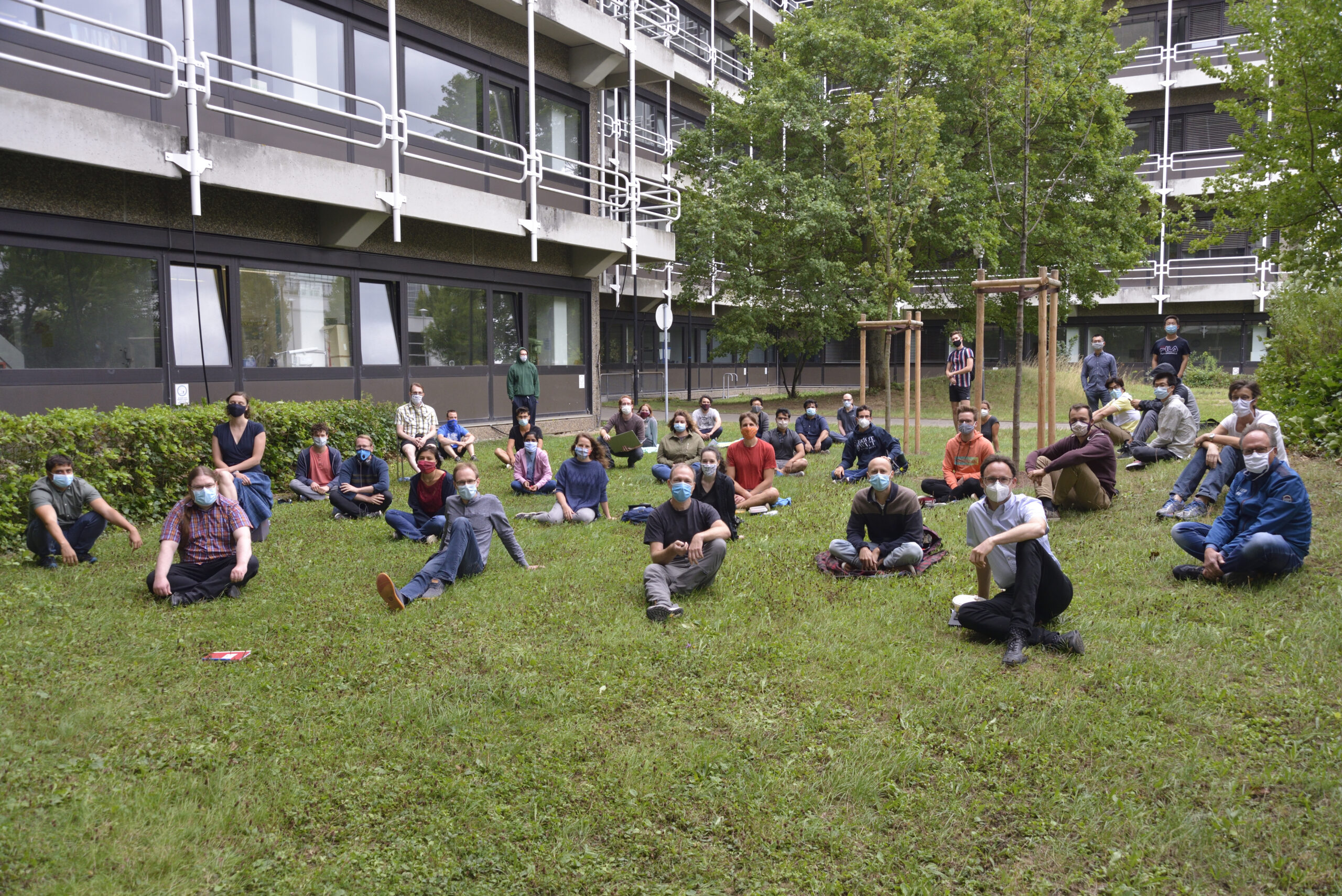March 2024: Raphael Gruber won the Einstein Slam at the DPG Spring Meeting 2024
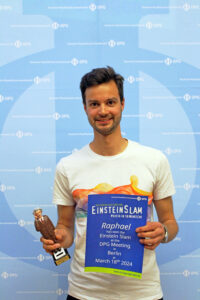
Raphael Gruber, PhD student in the group of Prof. Mathias Kläui, won the science slam at the spring meeting of the German Physical Society (DPG).
His 10-minute talk "Flat Dreams" was about how magnetic skyrmions arrange themselves in two dimensions - using the example of a shared flat. "I've been a fan of science slams for years and have often explained my research to friends using the example of the glass cupboard in a shared flat - that's how the idea for the slam came about."
The audience was impressed by his entertaining presentation and awarded him the Golden Einstein.
Picture: © Sophia Endberg / Deutsche Physikalische Gesellschaft
March 2024: Publication Highlight in Nature Communications: Altermagnetic CrSb with promising characteristics for electronic applications
Altermagnets represent a newly recognized class of materials in magnetism that could enable novel applications in spin-based electronics. Their magnetically ordered state consists of an antiparallel arrangement of microscopic magnetic moments, so-called spins, as in antiferromagnets. In contrast to antiferromagnetism, however, the altermagnetic state with zero net-magnetization enables the generation of electrical currents with spin polarization, as required in spin-based electronics. Thus, altermagnets combine the advantages of antiferromagnets, i.e., ultrafast dynamics, and ferromagnets, i.e., large spin polarization.
In collaboration with a theoretical team led by Professor Jairo Sinova and Dr. Libor Šmejkal, experimental physicist Dr. Sonka Reimers and her colleagues in Professor Mathias Kläui's lab at the Institute of Physics at Johannes Gutenberg University Mainz (JGU) have demonstrated altermagnetic electronic band splitting associated with spin polarization in CrSb. "The magnitude of this spitting, observed in a good conductor and at room temperature, is extraordinary and promising with regard to electronic applications of altermagnetic materials", said Professor Martin Jourdan, coordinator of the study recently published in Nature Communications.
One way of processing information based on topological magnetic particles is to use the magnetic vortices called skyrmions; a potential alternative are their still little understood and rarer cousins called 'merons'. Merons have to date only been observed in natural antiferromagnets, where they are difficult to both analyze and manipulate.
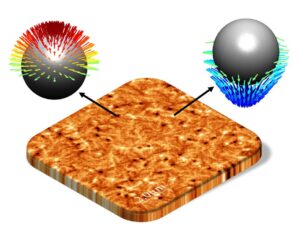
Working in collaboration with Prof. Takaaki Dohi at Tohoku University in Japan and the theory group of Prof. Jairo Sinova as well as the ALBA Synchrotron Light Facility in Spain, Mona Bhukta and colleagues at Kläui Lab have been the first to demonstrate the presence of merons in synthetic antiferromagnets and thus in materials that can be produced using standard deposition techniques. The research achievement involves designing synthetic antiferromagnets in such a way that merons are formed in them as well as the detection of the merons themselves. The full text of the publication in Nature Communications is accessible at https://www.nature.com/articles/s41467-024-45375-z
Our work “Mechanisms of Electrical Switching of Ultrathin CoO/Pt Bilayers” [C. Schmitt et al., Nano Lett. 24(5), 1471-1476 (2024)] made it as the cover page of Volume 24, Issue 5 of Nano Letters.
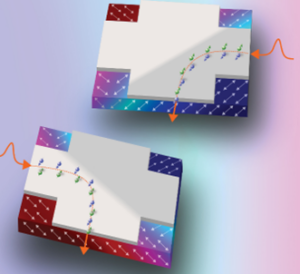
In the paper we study current-induced switching of the antiferromagnetic Néel vector in CoO/Pt bilayers to understand the underlaying switching mechanism. Surprisingly, spin Hall magnetoresistance measurements show that for ultrathin CoO/Pt bilayers pulses along the same path can lead to an increase or decrease of the signal, depending on the current density of the pulse. We compare these results to XMLD-PEEM imaging of the domain structure before and after the application of current pulses. With this we reveal that the observed changes in the spin Hall magnetoresistance signal can be explained by a thermomagnetoelastic switching mechanism. Moreover, the spatially resolved imaging reveals that regions where the electrical current is flowing and regions further away exhibit different switched spin structures, which can be explained by an interfacial spin−orbit torque-based switching mechanism that can dominate in very thin films. These findings are key as they demonstrate the interplay of the different switching mechanisms and thus motivate further research into thinner films, offering promising opportunities for utilizing AFMs in applications where electrical reading and efficient writing through SOTs is key.
Congratulations to Hendrik Meer, who obtained a distinction in his PhD on "Antiferromagnetic Insulatronics: Control and Manipulation of Magnetic Domains". In his studies, he investigated the effects of patterning, laser irradiation, and electrical currents on magnetic domains, thus establishing a set of tools to control the antiferromagnetic order in insulators. The latter results led to a first-author publication in Nano Letters.
Spintronics enables energy-efficient and persistent data storage. Typically, ferromagnets with operating frequencies in the gigahertz range are applied here. The operating frequency could be further increased with antiferromagnets, but these cannot be efficiently excited. Together with Mathias Weiler’s group from Kaiserslautern, we were able to show that magnetic heterostructures - each consisting of a thin layer of antiferromagnet and ferromagnet - can combine the advantages of both material classes. In such a heterostructure, we found a high working frequency with efficient excitation. The work has recently been published in Physical Review Letters and has been awarded as "Editor's suggestion". The full text of the publication is accessible at https://link.aps.org/doi/10.1103/PhysRevLett.131.046701
Antiferromagnets are attractive materials due to their spin dynamics in the THz regime. To realized narrowband THz spintronic devices, it has been proposed to use the intrinsic oscillations of the antiferromagnetic order. As part of an international collaboration, which was led by researchers from CNRS Thales including our previous postdoctoral researcher Romain Lebrun, we recently showed the generation of broadband and narrowband magnons in NiO/Pt films at 1 THz in low damping thin films of NiO/Pt. Two spin dynamics excitation processes were identified: instantaneous optical spin torque and strain-wave-induced THz torque. Both emitted a THz signal through the inverse spin Hall effect. Our research opens new opportunities for THz opto-spintronic devices based on antiferromagnetic materials.
The full text of the publication in Nature Communications is accessible at https://www.nature.com/articles/s41467-023-37509-6
In order to highlight an artistic aspect alongside the scientific and engineering perspectives of magnetism, the IEEE Magnetics Society, which organized the Intermag 2023 conference in Sendai, Japan, provided attendees with the opportunity to submit artistic and visually appealing images created during their magnetism-related research.
PhD student Klaus Raab of our group again became finalist in the Magnetism as Art showcase since he already had become finalist on the IEEE organized MMM conference 2022 in Minneapolis, USA. His contribution entitled “High tide in magnetic valley” shows a Kerr microscopy image of a CoFeB-based thin film which clearly illustrates the contrast between up and down magnetization (black and grey) while an additional horizontal magnetic in-plane field is applied.
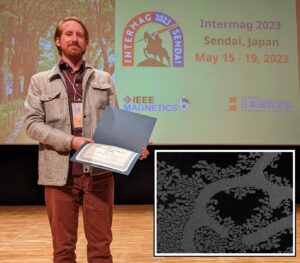
Antiferromagnets are attractive materials due to their spin dynamics in the THz regime. To realized narrowband THz spintronic devices, it has been proposed to use the intrinsic oscillations of the antiferromagnetic order. As part of an international collaboration, which was led by researchers from CNRS Thales including our previous postdoctoral researcher Romain Lebrun, we recently showed the generation of broadband and narrowband magnons in NiO/Pt films at 1 THz in low damping thin films of NiO/Pt. Two spin dynamics excitation processes were identified: instantaneous optical spin torque and strain-wave-induced THz torque. Both emitted a THz signal through the inverse spin Hall effect. Our research opens new opportunities for THz opto-spintronic devices based on antiferromagnetic materials.
The full text of the publication in Nature Communications is accessible at https://www.nature.com/articles/s41467-023-37509-6
We have an opening for a position till the end of 2028 as a Lecturer in Condensed Matter Physics! The official advert can be found here.
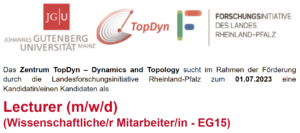
In a collaboration with colleagues in Beijing recently work on magnetic 3D spin structures was published in Science Advances. In this work we combined 3D magnetic hopfion spin structures with magnonics, showing that the scattering of magnons in 3D at the confined hopfion spin structures is strongly frequency dependent. By encoding the states of the effective neurons in the frequency distribution of the magnons we can use the frequency dependence of the magnon scattering for the operation. As hopfions can be in different states, one can use the overall setup for meta-learning.
This work was inspired by concepts from the ERC Synergy Grant 3D MAGiC that focuses on using 3D spin structures for unconventional computing approaches. The work was additionally supported by a Sino-German Mobility program.
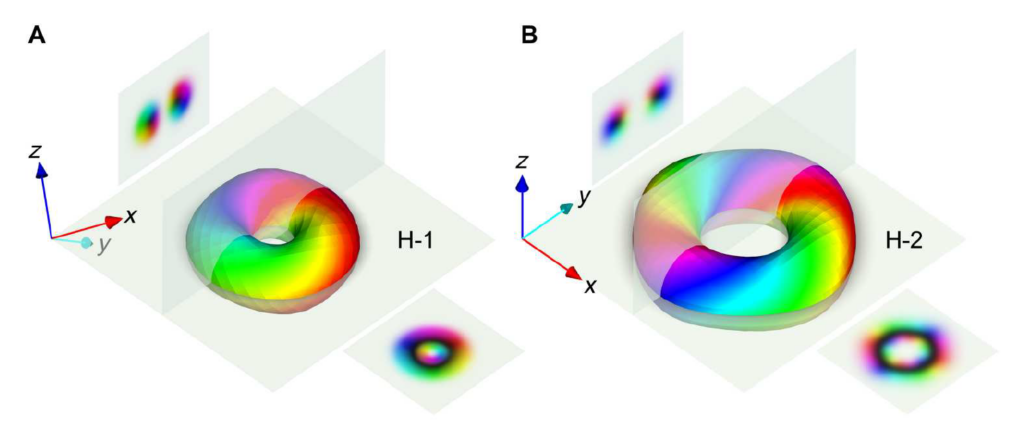
In this year’s iteration of our regular group retreat, we joint up with the groups of Prof. Eva Rentschler and Jun.-Prof. Angela Wittmann. We gathered in the picturesque mountain town of Partenen, Austria. The retreat, which was funded by Else and Wilhelm Heraeus Foundation, brought us together to share ideas, discuss new research directions, and enhance collaborations.
The retreat included a series of seminars during which we delved deep into our respective fields of study and exchanged ideas for potential new projects. The discussions were intense, but also highly productive, as many new ideas for collaborative projects were born. In addition to the intensive scientific work, we also took time to enjoy the beautiful surroundings of Partenen. Many of us took advantage of the excellent skiing and snowboarding opportunities in the area as well as great hiking routes.
The retreat was an incredible opportunity for us to come together and focus on our research in a unique and stimulating environment, which allowed us to have in-depth conversations and explore new ideas beyond what would have been possible in the usual workplace setting. We congratulate Maarten Brems and Mona Bhukta for winning the best presentation award and best poster award, respectively. Overall, the retreat was a huge success and we are grateful to the Wilhelm and Else Heraeus Foundation for the funding of this group retreat seminar.
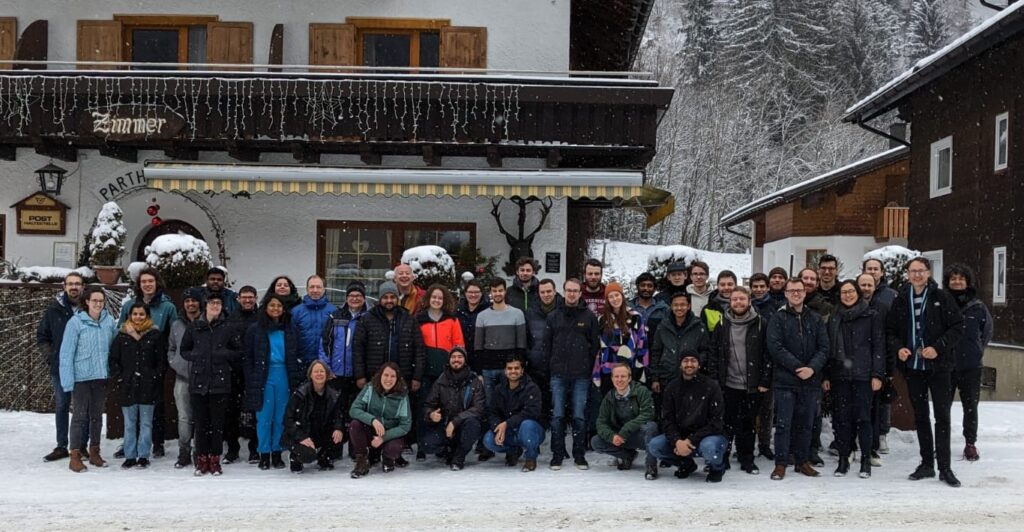
Both the Institute of Electrical and Electronics Engineers (IEEE) and the European Academy of Sciences (EURASC) honor Prof. Mathias Kläui for his achievements in research:
Being selected as Fellow, the highest degree of membership of IEEE is bestowed on Prof. Mathias Kläui. He is especially acknowledged for his contributions to next generation storage and logic devices as well as sensorics based on spintronics, leading to significant advances in engineering, science and technology.
Prof. Mathias Kläui is furthermore appointed a member of the European Academy of Sciences. He is honored for his work on magnetic materials in the class of materials science.
To emphasize an additional artistic approach to magnetism, IEEE magnetics society, which organized the Magnetism and Magnetic Materials Conference 2022 in Minneapolis, USA, asked the attendees for artistic and beautiful images created during their research related to magnetism and displayed 18 selected contributions on their Art Showcase Website. Further, 4 finalists of the 18 contributions were chosen by a committee of judges of the IEEE, which then were displayed openly as posters at the conference. Klaus Raab, PhD student of our group, has contributed an image entitled “Skyrmion pebble shore”, which was chosen as one of the 4 finalists of the Art showcase, and received $200 finalists price money.
Mr. Raab’s image shows skyrmion bubbles of opposite polarity at their respective oppositely magnetised background. The lower left of the picture was treated with He+ irradiation, changing the magnetic parameters, thus allowing for differently sized skyrmions and opposite polarity in comparison to the untreated top right. The boundary line between the treated and untreated area is clearly visible.
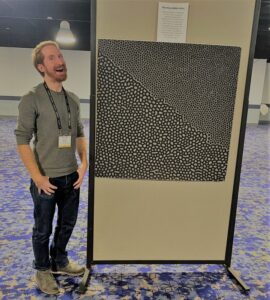
July 2022: Review on Orbitronics most-read article in 2021 in Europhysics Letters
Our Perspectives Review Article in EPL: Orbitronics: Orbital currents in solids is the most read article in EPL in 2021. In this review, we give an overview of recent progress and the current status of research
on orbital currents. We review proposed physical mechanisms for generating orbital currents and discuss candidate materials where orbital currents are manifest. We review recent experiments on orbital current generation and transport and discuss various experimental methods to quantify this elusive object at the heart of orbitronics —an area which exploits the orbital degree of freedom as an information carrier in solid-state devices.
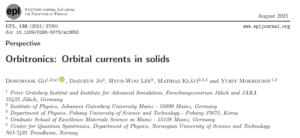
The full text of the publication in Europhysics Letters is accessible at:
https://iopscience.iop.org/article/10.1209/0295-5075/ac2653
June 2022: Cover Page of Applied Physics
Featured article in Journal of Applied Physics
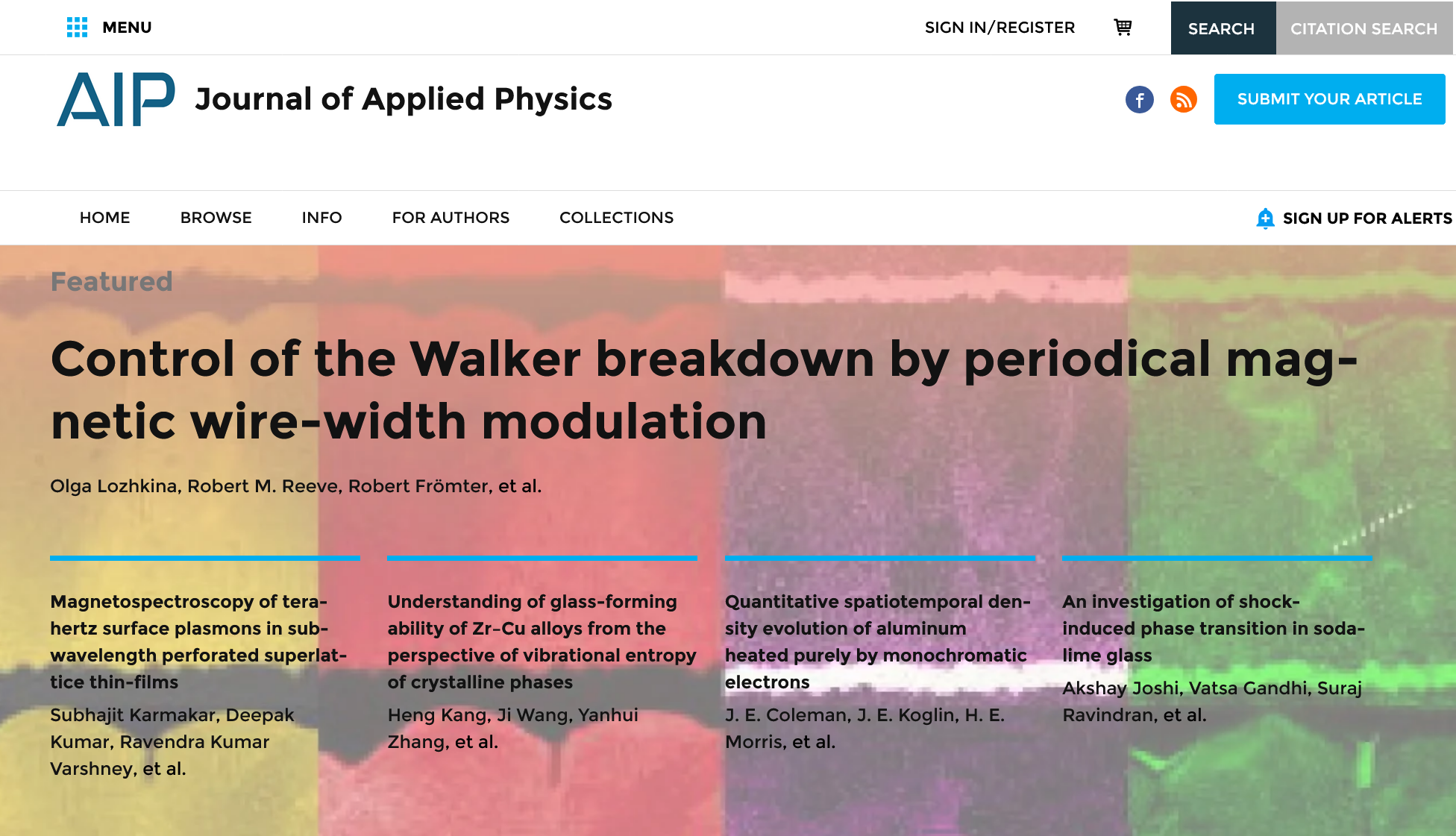
Suppression of the Walker breakdown in confined wires is key to improving the operation and reliability of magnetic domain-wall-based devices, including logic, memory, and sensor applications. Here, via micromagnetic simulations, we demonstrate that periodical wire-width modulation with suitable geometric parameters can fully suppress the Walker breakdown of a field-driven domain wall, conserving its spin structure in the whole operating field range of a device. Key differences in the efficacy of the wire-width modulation are observed for wires with different widths and thicknesses such that different domain wall states are energetically stable. In particular, the approach is found to be effective in expanding the field-operating window of a device in the case of smaller wire widths and thicknesses (below 150 nm wide and 15 nm thick), whereas in larger wires, the advantages from the suppression in the Walker breakdown are counteracted by the increase in domain wall pinning and the reduction in the nucleation field for new domain walls. Simulations on intersecting magnetic wires prove the importance of suppression of the Walker breakdown. Since the domain wall behavior is chirality dependent, introducing periodical wire-width modulation conserves the spin structure, thus reducing stochasticity of the domain wall propagation.
The full text of the publication in Journal of Applied Physics is accessible at:
https://aip.scitation.org/doi/10.1063/5.0092222
Besides local contributions from the University of Mainz, we were able to attract high level speakers from Germany as well as Chinse who joint us either on-site here in Mainz or remotely. Here are a few impressions from this workshop.
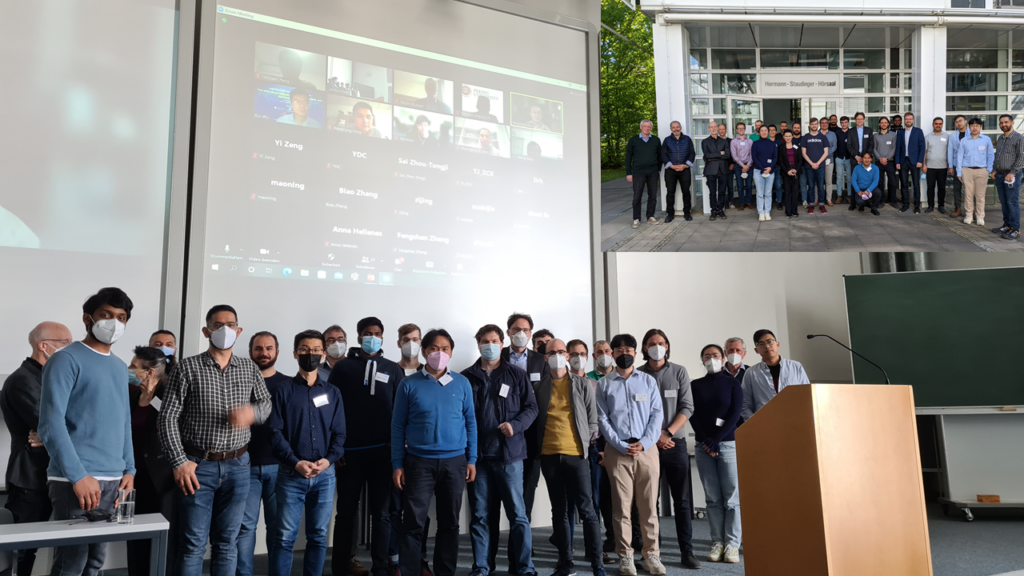
March 2022: IEEE Magnetics Society Distinguished Lecturer Presentation Online
An edited version of the Distinguished Lecturer Presentation by M. Kläui has been made available on the IEEE Magnetics Society Homepage (LINK to https://ieeemagnetics.org/index.php?option=com_content&view=article&id=300:victorino-franco&catid=85:202021-distinguished-lectures&Itemid=191)
Mathias Kläui was selected as one of the 2020/2021 IEEE Magnetics Society Distinguished Lecturers to highlight the emerging topic of antiferromagnetic spintronics. The video comprises an introduction to "Writing, reading and transporting spin in antiferromagnets" and is aimed at an audience interested in the latest developments in magnetism. The video can also be found here (LINK to http://download.klaeui-lab.de/show/IEEEDL.mp4). If anyone is interested in a copy of the slides, send an email to Mathias Kläui.
February 2022: Editors suggestion in Physical Review Letters
The transport of angular momentum in solids is typically associated to the spin momentum of the electrons or to magnon transport. We found a magnetoresistance (MR) that could originate from the orbital angular momentum (OAM) transport in a permalloy (Py)/oxidized Cu (Cu*) heterostructure: the orbital Rashba-Edelstein magnetoresistance. This is the first experimental observation of this theoretically predicted effect. Despite the absence of elements with large spin-orbit coupling, we find a sizable MR ratio, which is in contrast to the conventional spin Hall magnetoresistance which requires heavy elements. Through Py thickness-dependence studies, we conclude another mechanism beyond the conventional spin-based scenario is responsible for the MR observed in Py/Cu* structures—originated in a sizable transport of OAM. Our findings not only suggest the current-induced torques without using any heavy elements via the OAM channel but also provide an important clue towards the micstyroscopic understanding of the role that OAM transport can play for magnetization dynamics.

Schematic of a permalloy/copperoxide/copper heterostructure where orbital angular momentum currents in the copper oxide are converted to spin currents in the permalloy (bottom layer).
The full text of the publication in Physical Review Letters is accessible at:
https://journals.aps.org/prl/abstract/10.1103/PhysRevLett.128.067201
November 2021: Publication Highlight in Nature Communications
A novel approach promising ultrafast and stable magnetic memory is the use of antiferromagnets as active elements in spin-based electronics devices (spintronics). Though these materials lack a macroscopic magnetization, they possess a staggered orientation of their microscopic magnetic moments which leads to intrinsic dynamics in the Terahertz (THz) range and robustness against external magnetic fields. However, technologically relevant read-out in spintronics requires significantly large magnetoresistance effects and is currently a major challenge in antiferromagnetic spintronics. Within an international collaboration, we were able to demonstrate a strong exchange coupling of very thin ferromagnetic overlayers to the prototypical antiferromagnetic spintronics compound Mn2Au. This allows us to benefit from the well-established read-out methods of ferromagnets, enabling large magnetoresistance effects also in antiferromagnetic spintronics. Additionally, imprinting of the antiferromagnetic domain pattern on the ferromagnetic overlayer enables its in-house visualization via conventional imaging techniques for ferromagnets.
The full text of the publication in Nature Communications is accessible at: https://www.nature.com/articles/s41467-021-26892-7.
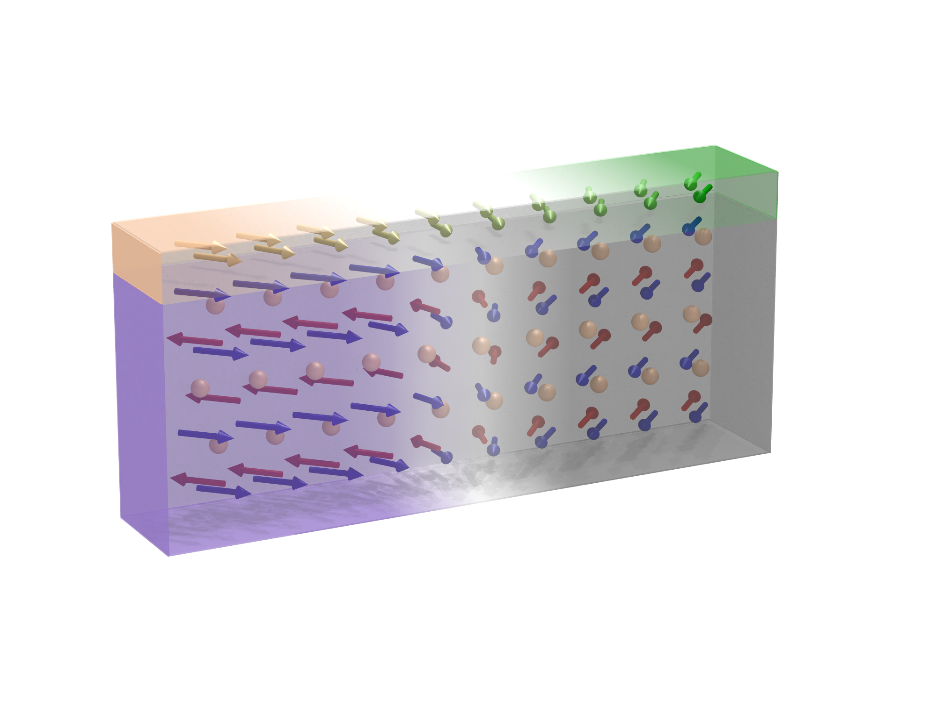
Schematic of an exchange coupled Mn2Au (bottom layer) – ferromagnet bilayer, in which the antiferromagnetic domain pattern is perfectly imprinted into the ferromagnet (top layer).
October 2021: Mainz ranked #1 in Physics in Germany in the German Research Foundation Funding Atlas
In the 2021 Funding Atlas of the German Research Foundation (DFG), Johannes Gutenberg University Mainz (JGU) garners first place in the field of Physics by a clear margin. In this discipline alone, Mainz University received some EUR 45 million in funding from the DFG in the years 2017 to 2019, more than any other university in Germany.
More information can be found here: https://www.uni-mainz.de/presse/aktuell/14290_ENG_HTML.php.
September 2021: Former PhD student Dr. Isabella Boventer is finalist for young scientist award at TMAG conference
At the Trends in Magnetism 2021 Conference Isabella Boventer was selected as a finalist for the young scientist award. Isabella carried out her PhD in our group on Cavity Magnon-Polariton Spectroscopy and then she moved on to a Postdoc position in Paris. Congratulations to Isabella!
At the same conference Mathias Kläui was invited for a distinguished lecture on Antiferromagnetic Insulatronics.
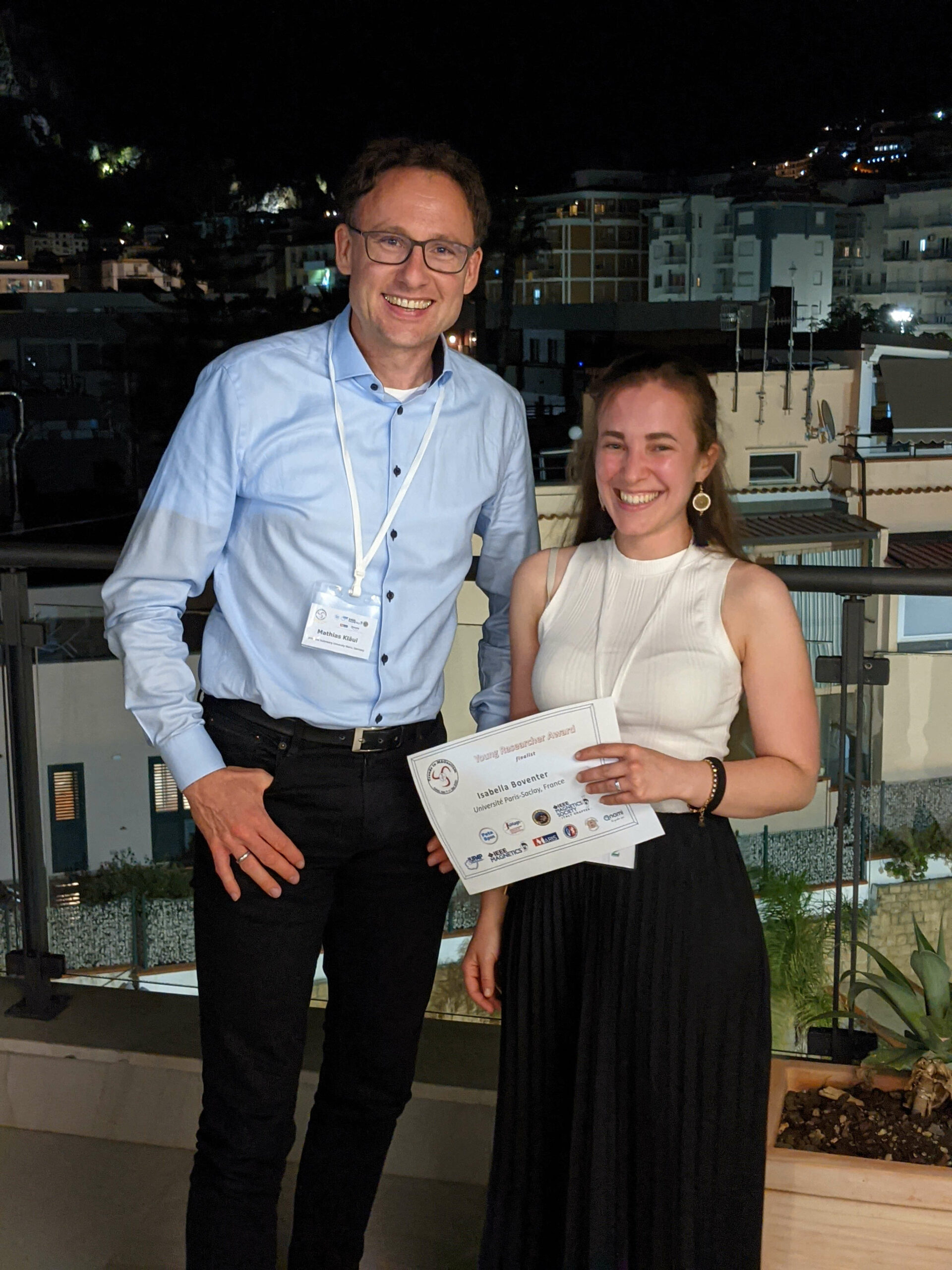
August 2021: Top Ranking for Physics in Mainz
In this year's Shanghai ranking we have again been ranked in top 5 in Germany and top 75 worldwide. Johannes Gutenberg University Mainz (JGU) has consistently achieved a top spot for physics in the major rankings in the recent past (#1 in the German Research Foundation's recent ranking, top 5 or top 10 in Shanghai and Nature Index ranking, etc.).
With a large number of national collaborative research centres, the Max Planck Graduate Centre and the Cluster of Excellence PRISMA physics hosts major research activities.
June 2021: Mariia Filianina receives Professor-Herminghaus-Prize for her PhD thesis
In her PhD thesis entitled “Electric field-induced strain control of magnetism in in-plane and out-of-plane magnetized thin films”, Mariia demonstrated that electric field-induced strain is a promising tool for energy efficient manipulations of nanoscale magnetic structures. It ensures reliable control of not only the static magnetic configuration, but also the magnetodynamic response of the system. This approach can potentially be combined with other means, for example spin torques, and implemented in more advanced device architectures.
Mariia and four other awardees received their certificates from JGU President Prof. Dr. Georg Krausch at this year’s corona-related small-scale award ceremony on June 30th.
More information can be found here (in German): https://www.gnk.uni-mainz.de/dies-academicus/preisverleihung-2021.
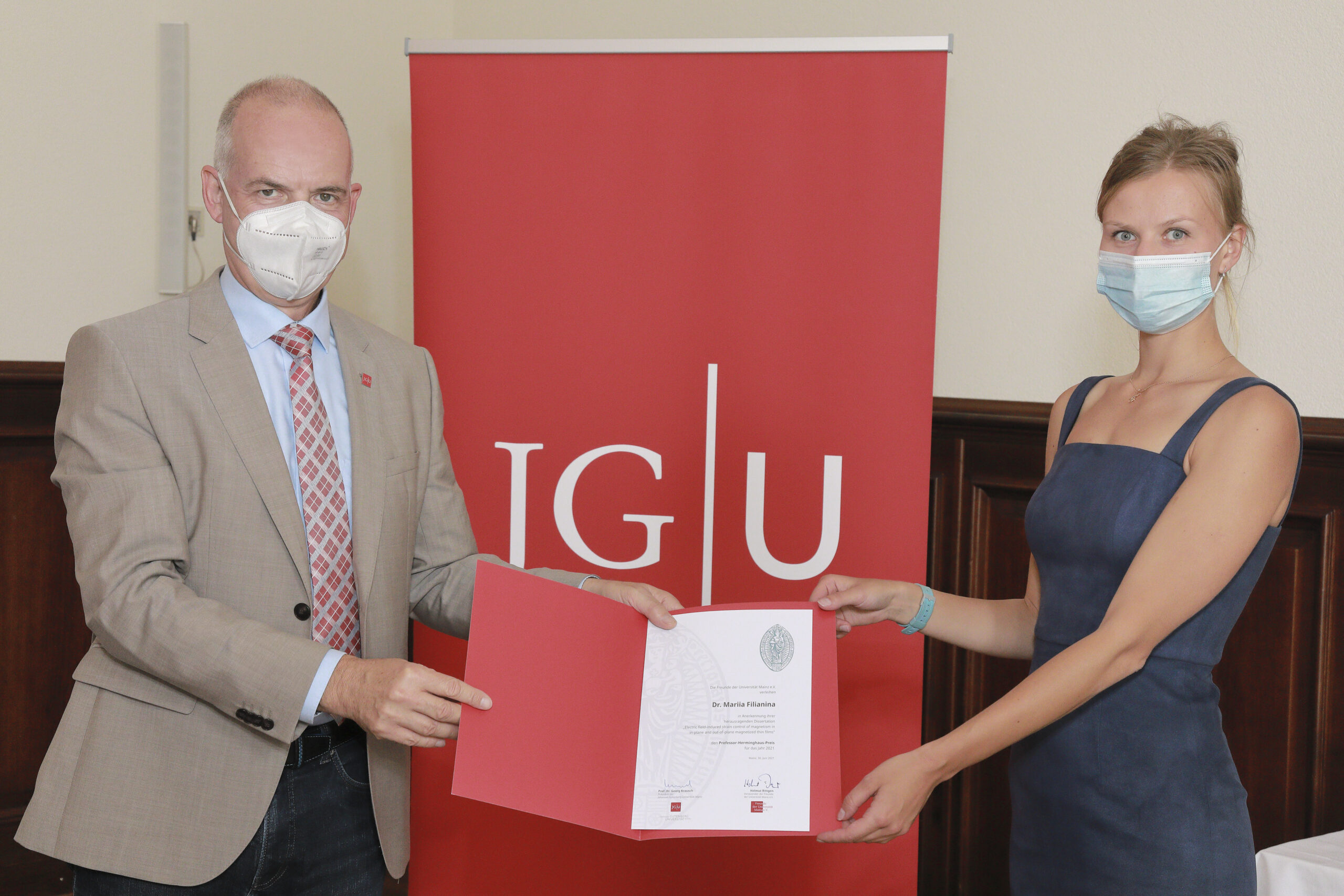
JGU President Prof. Dr. Georg Krausch and Mariia Filianina. Photo by “Agentur Sämmer”
May 2021: Publication Highlight in Physical Review Letters
Antiferromagnets are particularly promising for next generation magnetic devices as their dynamics is orders of magnitude faster than for conventional ferromagnets. Furthermore they are largely immune to stray fields thus being promising for ultra-stable memory devices. To understand the dynamics, in a collaboration led by former Mainz PhD student I. Boventer with colleagues from the Centre of Excellence for Quantum Spintronics, we studied the dynamics of the antiferromagnet hematite, the main component of "rust". In the work "Room-Temperature Antiferromagnetic Resonance and Inverse Spin-Hall Voltage in Canted Antiferromagnets", we could demonstrate that we can generate large electrical signal resulting from the antiferromagnetic spin dynamics thus allowing for electrical detection of the dynamics. The electrical signal furthermore allows us to identify the mode handedness of the dynamic eigenmode.
The full text of the publication in Physical Review Letters is accessible at: https://journals.aps.org/prl/abstract/10.1103/PhysRevLett.126.187201.
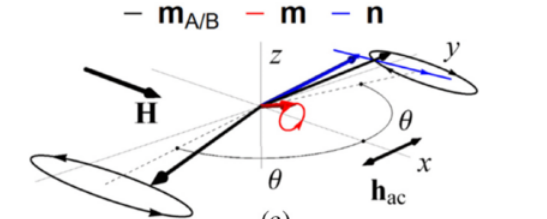
May 2021: Publication Highlight in Physical Review X
Understanding magnetoresistance effects at THz frequencies is key to using magneto-resistivie devices at ultra-high frequencies. In a collaboration led by the research group of Tobias Kampfrath (Freie Universität Berlin/Fritz Haber Institute of the Max Planck Society, Berlin), we have studied the anisotropic magnetoresistance at frequencies from the DC regime to tens of THz. We find that we can explain the frequency dependence in Ni and Co we identify both intrinsic as well as extrinsic contributions and we find a sizeable magnetoresistance even at the highest frequencies. This demonstrates that magneto-resistive devices can operate at tens of THz frequencies orders of magnitude faster than current microelectronics devices.
The full text of the publication in Physical Review X is accessible at: https://journals.aps.org/prx/abstract/10.1103/PhysRevX.11.021030.
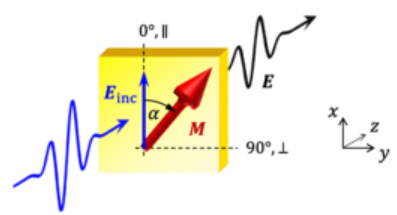
March 2021: Publication Highlight in Advanced Functional Materials
Movement of skyrmions is heavily impacted by geometric confinement of skyrmion positions. Better understanding this impact is required for applications such as Brownian computing and skyrmion-based information storage. In our recent work in collaboration with the theory group of PD Dr. Peter Virnau, titled “Commensurability between Element Symmetry and the Number of Skyrmions Governing Skyrmion Diffusion in Confined”, we performed experiments and computer simulations of skyrmion movement in different geometric confinements. For example, using a triangular confinement, both in experiments and simulations skyrmions diffused less for commensurate states of 3, 6 or 10 skyrmions which were regularly ordered compared to different skyrmion numbers that do not fit into the triangle in an ordered manner.
Additional information can be found in the press release on the JGU website: https://www.uni-mainz.de/presse/aktuell/13181_ENG_HTML.php (English) or https://www.uni-mainz.de/presse/aktuell/13181_DEU_HTML.php (Deutsch).
The full text of the publication in Advanced Functional Materials is accessible at: https://onlinelibrary.wiley.com/doi/10.1002/adfm.202010739.

February 2021: The Newspaper "DIE ZEIT" highlights top research at JGU in ZEIT Campus
ZEIT Campus published an article about the top research of the JGU Mainz, highlighting projects like TopDyn. In this initiative we are striving to find sustainable chemical solutions for material development, raw material supply, energy conversion and production processes.
February 2021: Andrew Ross obtaining a distinction in his PhD
Congratulations to Andrew Ross, who obtained a distinction in his PhD on "Probing Magnetostatic and Magnetotransport Properties of the Antiferromagnetic Iron Oxide Hematite". In his studies, he showed the extraction of magnetic anisotropies for insulating antiferromagnets from surface sensitive measurements and pioneered the long-distance transport of antiferromagnetic magnons. The latter results led to first-author publications in Nature and Nano Letters and a co-authored publication in Nature Communications.
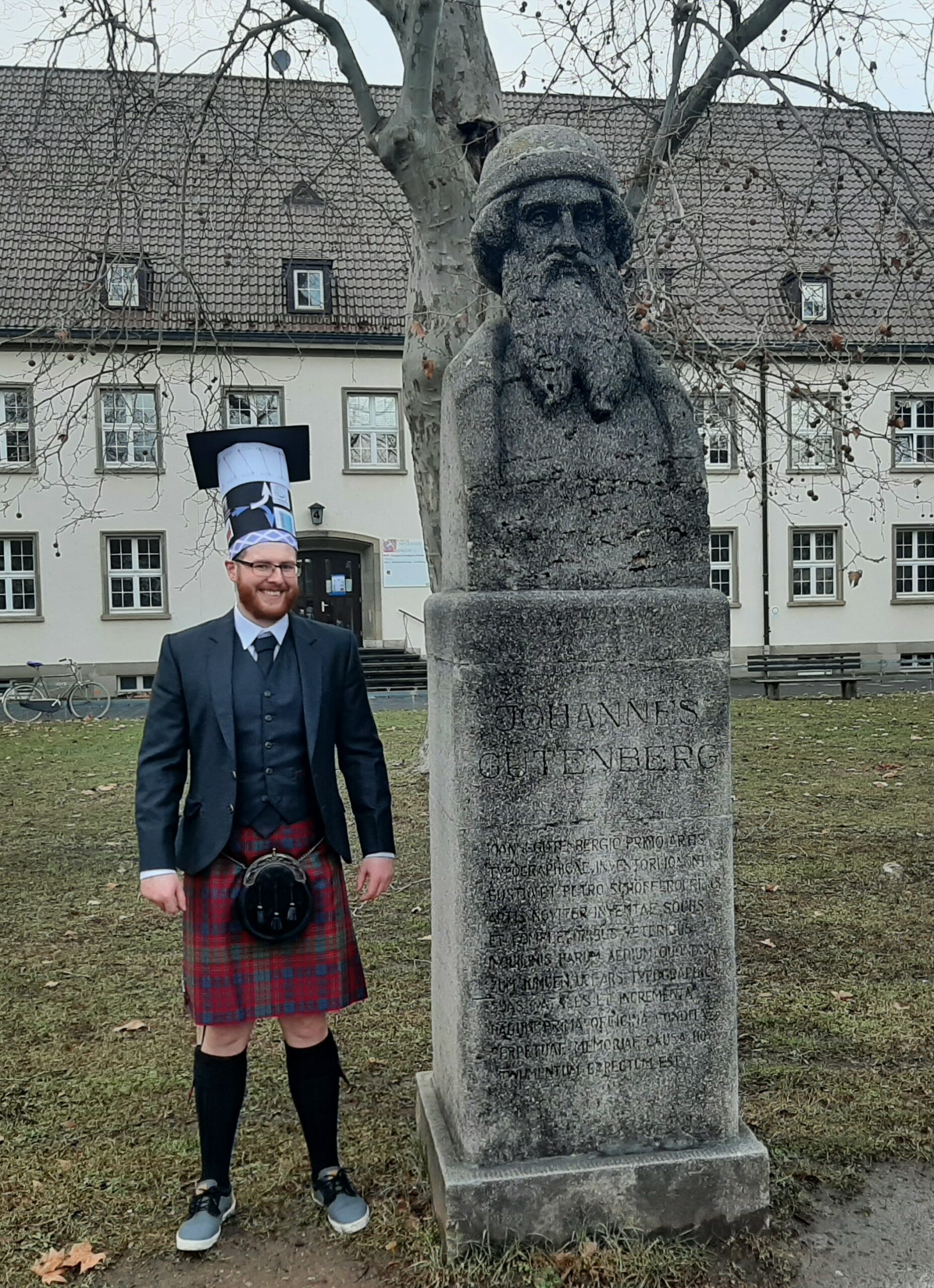
January 2021: Tom G. Saunderson wins Best Poster Prize at the 736. Wilhelm und Else Heraeus-Seminar on Magnetism at the Nanoscale: Imaging - Fabrication – Physics 2021 hosted online in January 2021
The poster “Orbital decomposition of Yu-Shiba-Rusinov resonances from magnetic impurities in multiband superconducting Pb” by Tom G. Saunderson was selected for a best poster award at the “736. Wilhelm und Else Heraeus-Seminar on Magnetism at the Nanoscale: Imaging - Fabrication – Physics 2021”. The work focuses on Tom’s PhD at the University of Bristol, completed in October 2020, which investigates the effects of magnetic impurities on bulk and surface superconducting Pb from first principles. The orbital character of the ensuing Yu-Shiba-Rusinov bound states are assessed, making contact to experimental observations. This research was conducted under the supervision of Dr. Martin Gradhand and funded by the UKRI engineering and physical research council (https://www.epsrc.ukri.org) through the centre for doctoral training in condensed matter physics (https://www.cdt-cmp.ac.uk).
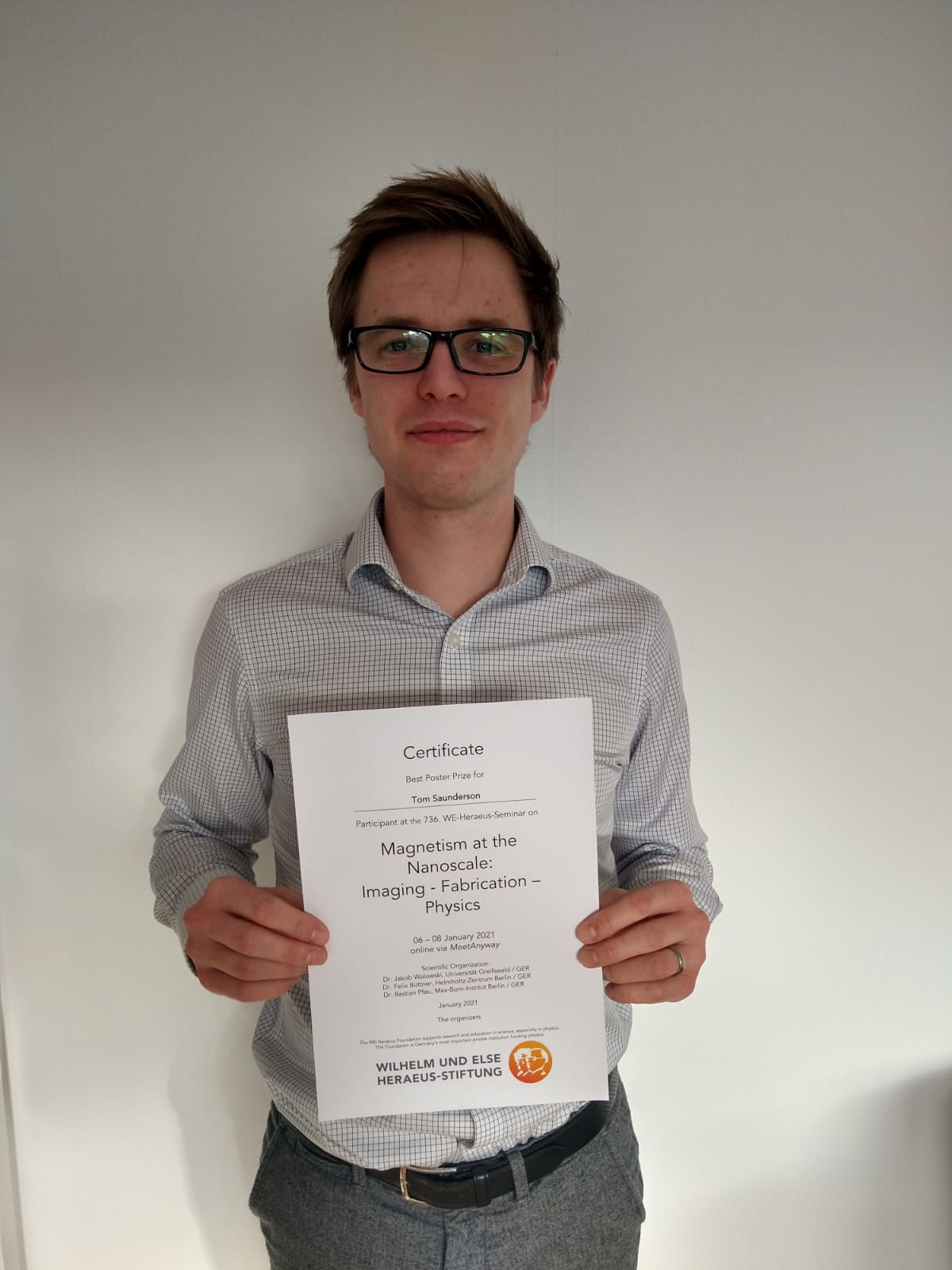
January 2021: Mariia Filianina obtaining a distinction in her PhD
Congratulations to Mariia Filianina, who obtained a distinction in her PhD on the "Electric field-induced strain control of magnetism in in-plane and out-of-plane magnetized thin films". In her studies, she investigated the impact of energy-efficient strain on various magnetic phenomena, such as magnetic vortex dynamics and spin-orbit torques. The latter results led to a first author publication in Physical Review Letters.
December 2020: Publication Highlight in Nature Communications
A joint research project of Johannes Gutenberg University Mainz (JGU), the University of Siegen, Forschungszentrum Jülich, and the Elettra Synchrotron Trieste has achieved a new milestone for the ultra-fast control of magnetism. The international team has been working on magnetization configurations that exhibit chiral twisting. Magnetization configurations with a fixed chirality are currently investigated intensively due to their fascinating properties such as enhanced stability and efficient manipulation by current. These magnetic textures thus promise applications in the field of ultrafast chiral spintronics, for example in ultrafast writing and controlling of chiral topological magnetic objects such as magnetic skyrmions, i.e., specially twisted magnetization configurations with exciting properties.
The new insights published in Nature Communications shed light on the ultrafast dynamics after optical excitation of chiral spin structures compared to collinear spin structures. According to the researchers' findings, the chiral order restores faster compared to the collinear order after excitation by an infrared laser.
The research team performed small angle x-ray scattering experiments on magnetic thin film samples stabilizing chiral magnetic configurations at the free electron laser (FEL) facility FERMI in Trieste in Italy. The facility provides the unique possibility to study the magnetization dynamics with femtosecond time resolution by using circular left polarized or right polarized light. The results indicate a faster recovery of chiral order compared to collinear magnetic order dynamics, which means that twists are more stable than straight magnetic configurations.
Additional information can be found in the press release on the JGU website:
https://www.uni-mainz.de/presse/aktuell/12709_ENG_HTML.php (English)
https://www.uni-mainz.de/presse/aktuell/12709_DEU_HTML.php (Deutsch)
The full text of the publication in Physical Review Letters is accessible at: https://www.nature.com/articles/s41467-020-19613-z
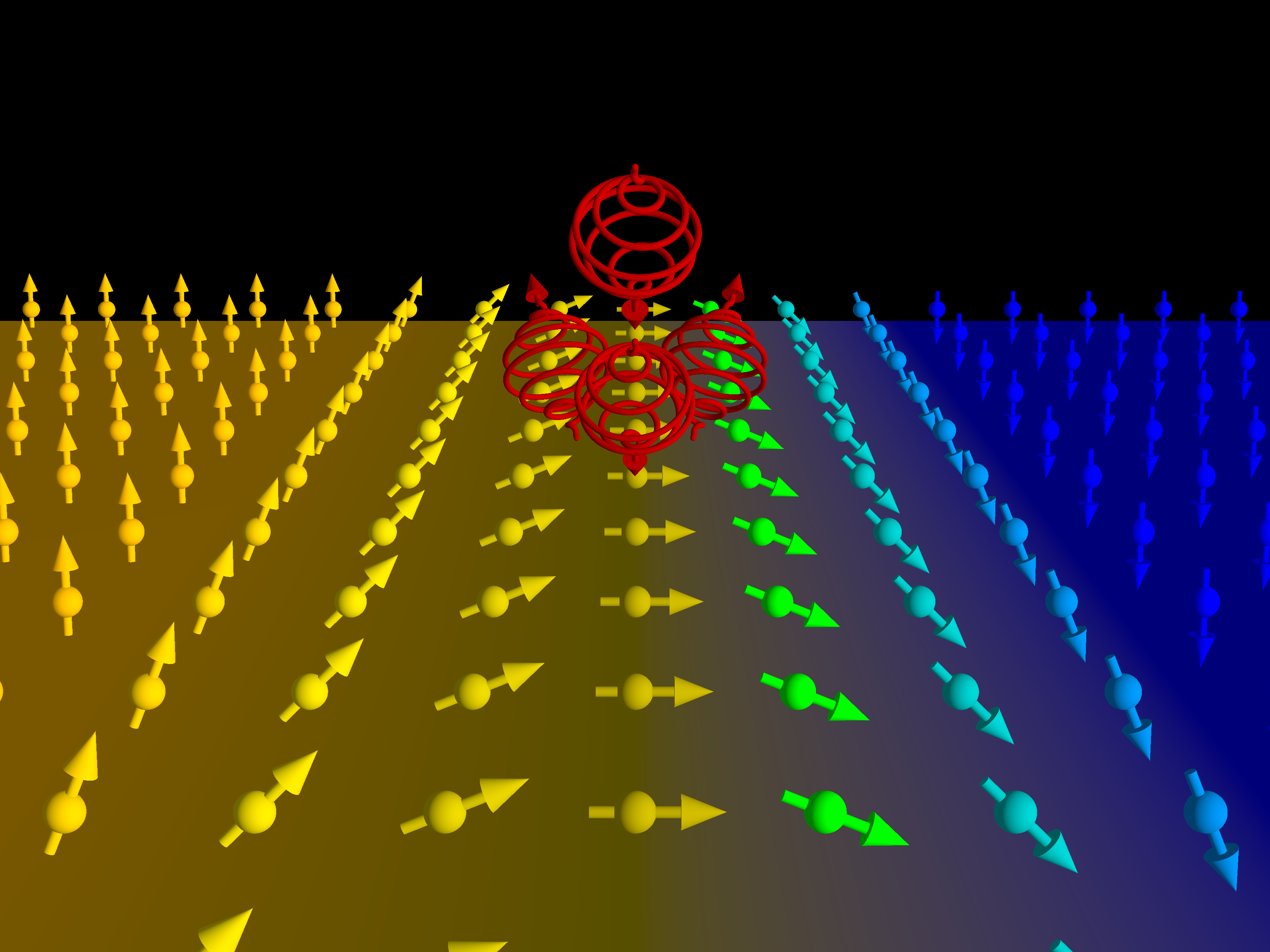
Figure: Incoming circular left polarized (CL) and right polarized (CR) x-ray pulses scatter differently on chiral magnetic domain walls, leading to an asymmetry observed in the difference signal (CL-CR).
December 2020: Publication Highlight in Nature Communications
Enabling magnonic devices centred on antiferromagnetic materials requires robust magnon propagation at room temperature. Previously, magnon transport has been shown in the antiferromagnetic phase of iron oxide, hematite, but at temperatures far below room temperature. These temperatures are needed to stabilise an easy-axis anisotropy which leads to circularly polarized magnons capable of transporting angular momentum. In our recent work titled “Long-distance spin-transport across the Morin phase transition up to room temperature in ultra-low damping single crystals of the antiferromagnet α-Fe2O3” we demonstrate that the propagation of magnons persists from low temperatures to room temperature, through the Morin transition to an easy-plane anisotropy where circularly polarised magnons cannot propagate. We find that a superposition of linearly polarised magnon modes approximating a net circular polarisation enables long-distance magnon transport.
Additional information can be found in the press release on the JGU website: https://www.uni-mainz.de/presse/aktuell/12744_ENG_HTML.php (English) or https://www.uni-mainz.de/presse/aktuell/12744_DEU_HTML.php(Deutsch)
The full text of the publication in Nature Communications is accessible at: https://www.nature.com/articles/s41467-020-20155-7

November 2020: Felix Schreiber receives Best Student Presentation Award at the MMM 2020 virtual conference
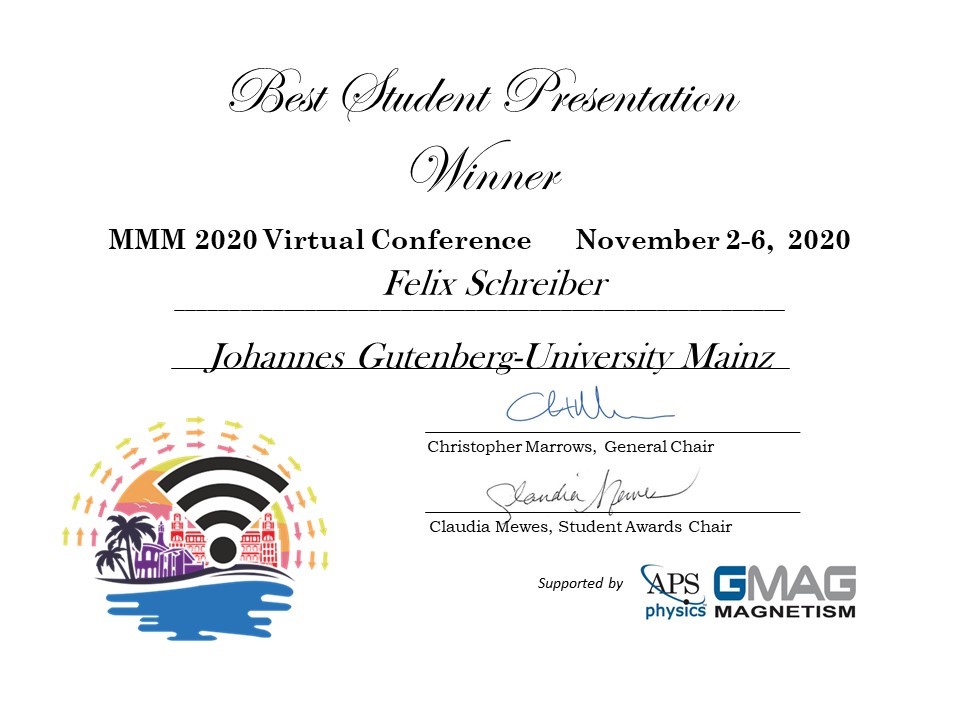
Presenting our recent work “Concurrent magneto optical imaging and magneto-transport readout of electrical switching of insulating antiferromagnetic thin films” [Appl. Phys. Lett. 117, 082401 (2020) https://doi.org/10.1063/5.0011852] in a 10min talk and a live Q&A session, Felix Schreiber received the Best Student Presentation Award for his talk at the MMM 2020 virtual conference. The online event featured over 1000 sessions reviewing the latest advances in both fundamental and applied magnetism.
November 2020: Publication Highlight in Physical Review Letters
The electrical manipulation of magnetism via current-driven spin-orbit torques (SOTs) promises efficient spintronic devices, for which one needs to realize a large SOT efficiency. Engineering the SOT efficiency is predominantly achieved by maximizing or modulating the nonequilibrium spin density that builds up at magnetic layer/heavy metal interfaces through the spin Hall and inverse spin galvanic effects. Regardless of the origin, the fundamental requirement for efficient SOTs is a net spin accumulation. In our paper entitled “Harnessing Orbital-to-Spin Conversion of Interfacial Orbital Currents for Efficient Spin-Orbit Torques”, published in Physical Review Letters, we report on the large enhancement of the SOT efficiency in thulium iron garnet (TmIG)/Pt by capping with a CuOx layer. An orbital current generated at the Pt/CuOx interface is converted to a spin current as it decays across the Pt layer due to the large spin-orbit coupling in Pt. This then exerts a “nonlocal” torque on the magnetic material TmIG. Our work offers a route to increasing the efficiency of current-driven torques while at the same time offering key insights into the underlying physics of orbital transport.
The full text of the publication in Physical Review Letters is accessible at: https://journals.aps.org/prl/abstract/10.1103/PhysRevLett.125.177201
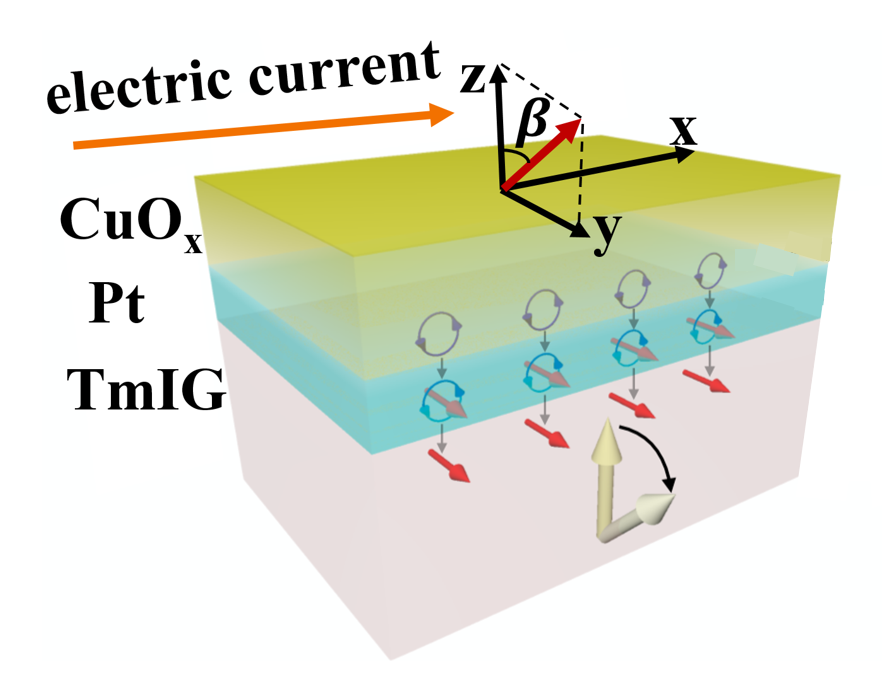
Figure: Schematic illustration of “nonlocal” generation of SOTs in TmIG / Pt / CuOx structures. The orbital angular momentum (indicated by blue circulations) is generated at the Pt / CuOx interface and injected into the Pt. Due to the large spin-orbit coupling of the Pt, the orbital angular momentum is converted to a spin current (indicated by red arrows), which diffuses across the Pt and exerts a torque on the magnetic moments (yellow arrow) of the TmIG layer.
September 2020: Publication Highlight in Advanced Functional Materials
In the TopDyn collaboration of our experimental group, the theoretical group of Dr. Virnau and our esteemed former colleague Dr. Zázvorka, we investigated examples of two-dimensional phases and phase transitions using the model system of skyrmions nucleated in thin metal films. Magnetic skyrmions form regular lattices due to their repulsive interactions, which can be considered as a two-dimensional crystallization. In these ordered lattices skyrmions behave like disks, with the great advantage that the size and number of skyrmions can be controlled via magnetic fields. This enables the observation of different phases and phase transitions, which are not possible in three dimensions. A famous example is the Kosterlitz-Thouless transition, for the description of which the Nobel price 2016 was awarded. Another example is the hexatic phase, occurring between the liquid and solid phase of hard disks. Our system shows evidence for an incipient hexatic phase, validating the use of skyrmions as an example of hard disks in a two-dimensional phase transition. Additionally, we were able to simulate the repelling interaction of the skyrmions and more ordered lattices. Our results are now published in the journal Advanced Functional Materials with the title Skyrmion Lattice Phases in Thin Film Multilayer.
Additional information can be found in the press release on the JGU website: https://www.uni-mainz.de/presse/aktuell/12071_ENG_HTML.php
The full text of the publication in Advanced Functional Materials is accessible at: https://onlinelibrary.wiley.com/doi/full/10.1002/adfm.202004037?af=R
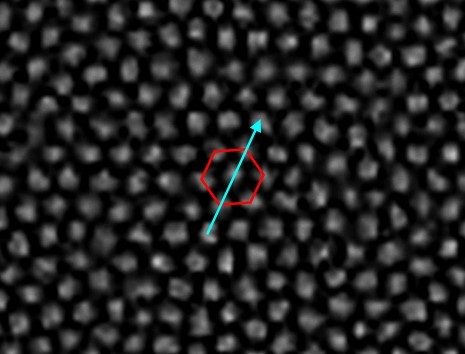
Figure: skyrmions forming a hexagonal oriented lattice
August 2020: Cover Page of Applied Physics Letters
Magneto-optical imaging of current-induced switching of insulating antiferromagnetic thin films
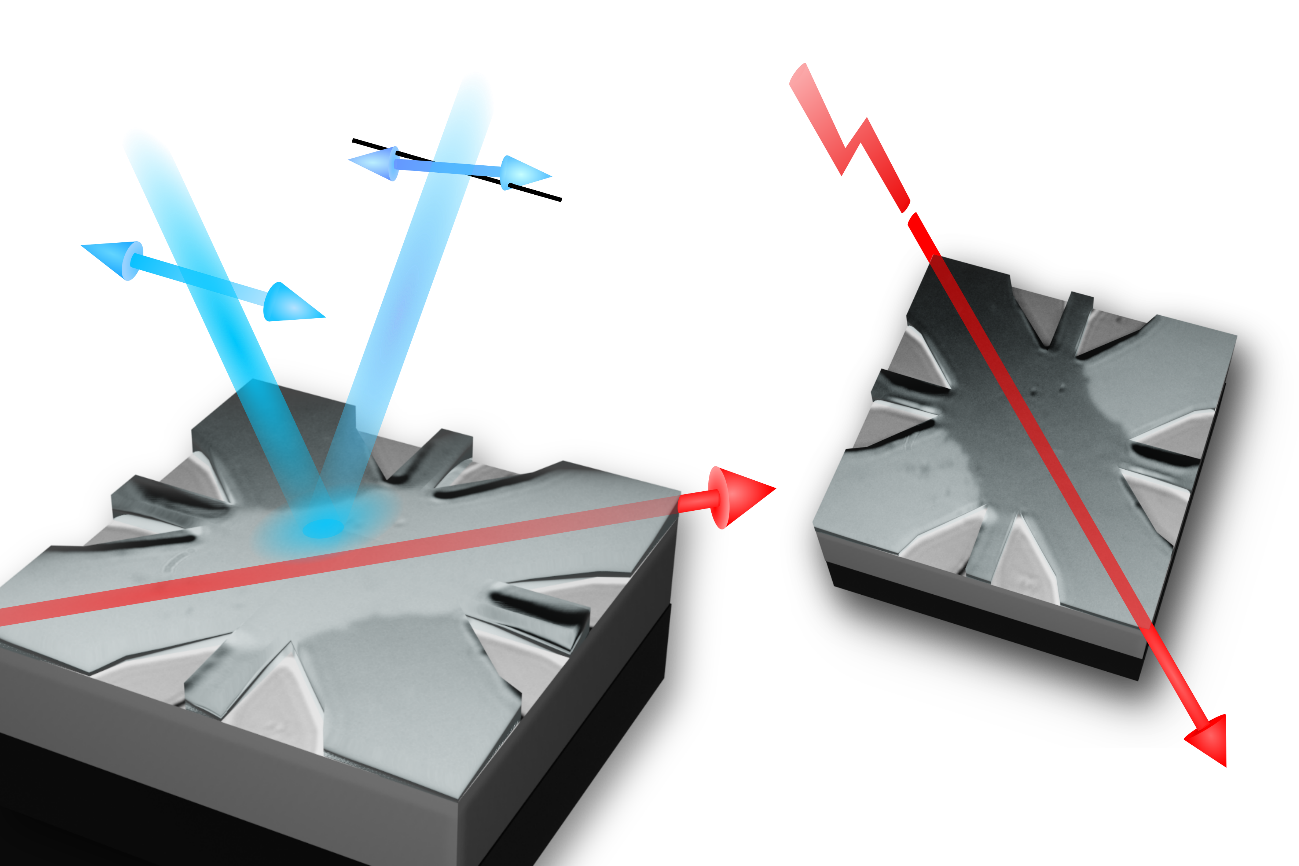
Our work “Concurrent magneto-optical imaging and magneto-transport readout of electrical switching of antiferromagnetic thin films” [F. Schreiber et al., Appl. Phys. Lett. 117, 082401 (2020) https://doi.org/10.1063/5.0011852] made it as the cover page of Volume 117, Issue 8 of Applied Physics Letters.
In the paper we use a table-top approach to demonstrate stable and reversible current-induced switching of large-area antiferromagnetic domains in NiO/Pt by direct imaging in a Kerr microscope. Concurrent transport and magneto-optical imaging measurements allow us to correlate the AFM domain switching fraction and magneto-transport signal response. While the observation of magnetic domain switching indicates the presence of a magnetic SMR response, we also confirm the presence of artificial resistance changes in the Pt layer. The introduction of a simple procedure to subtract these non-magnetic contributions from the transverse resistance signal yields the disentanglement of magnetic and non-magnetic contributions. Across many different current densities, we find an accurate correlation of post-treated electrical signal and domain switching fraction, calculated from the imaging. This corroborates the validity of the subtraction procedure and allows us to distinguish the presence of a significant electrical SMR response, directly correlated with the switching of the antiferromagnetic domains.
We emphasize the potential of insulating AFMs by highlighting the possibility to quantify the antiferromagnetic domain switching fraction from simple transport measurements. These findings can both motivate and simplify additional research to enable using insulating AFMs in applications where electrical reading and writing are required.
August 2020: Publication Highlight in Physical Review Letters
Efficient switching of insulating antiferromagnets
Antiferromagnetic materials are magnetic materials that do not generate a magnetic field, due to the alternated magnetic moments. To make insulating antiferromagnetic materials useful as building blocks of future spintronic devices for memory and computing operations, and exploit the potentially fast operation speed, robustness against external magnetic fields and higher bit density compared to ferromagnets, one needs to realize reading and writing operations efficiently. Reading has been demonstrated by the spin Hall magnetoresistance for many compounds while electrical writing is being debated, with some authors reporting efficient switching and others reporting absence of magnetic switching. In our paper entitled “Efficient Spin Torques in Antiferromagnetic CoO/Pt Quantified by Comparing Field- and Current-Induced Switching”, published in Physical Review Letters, we demonstrate current-induced switching of an antiferromagnetic CoO thin film and we determine the switching efficiency electrically by current-induced and field-induced switching. This demonstration is a key step in view of applications.
Additional information can be found in the press release on the JGU website: https://www.uni-mainz.de/presse/aktuell/11958_ENG_HTML.php
The full text of the publication in Physical Review Letters is accessible at https://journals.aps.org/prl/abstract/10.1103/PhysRevLett.125.077201.
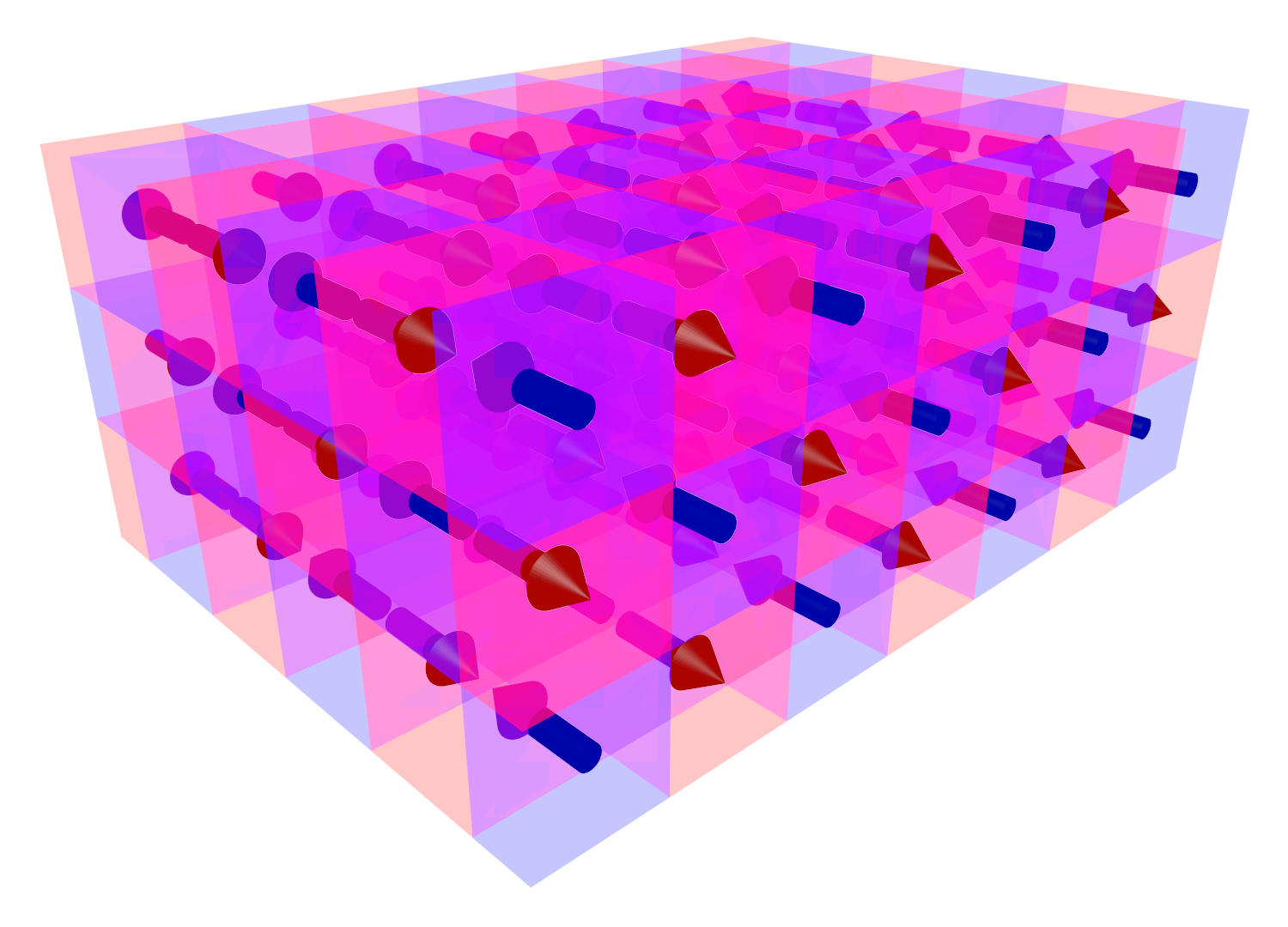
Figure 1: Example of antiferromagnetic material, with antiparallel alignment of the magnetic moments.

Figure 2: Currents and fields can switch the magnetic moments in the same manner.
July 2020: Publication Highlight in Physical Review Letters
Making energy-efficient switching of memory cells even more efficient
Magnetic memory relies on using the magnetization direction of individual ferromagnetic cells to store binary information. Nowadays, the most efficient way to switch the magnetization direction, i.e. to write or delete a bit of information, is by using so-called spin torques. These torques arise in certain, typically, thin multilayer films when an electric current is passed through them, and the larger the torque, the less current is required for the switching, thus led energy is dissipated in the device. It is known that the magnitude of the torques varies when altering the systems constituents, for example, changing the materials or the layer thicknesses. In this case, however, the torques remain fixed once the multilayer is fabricated. In the light of developing a new generation of devices with simplified architectures and decreased power consumption, of key importance is to be able to control the spin torques “on the fly”. Our results recently published in Physical Review Letters demonstrate for the first time experimentally that the low-power control of the spin torques can be achieved by means of piezoelectric strain, which we explain by advanced theoretical calculations carried out in the collaboration with Jan-Philipp Hanke and Yuriy Mokrousov within the TopDyn – Dynamics and Topology Research Centre.
We generate and control the piezoelectric strain by low-power electric fields, which is an energy-efficient approach as it avoids using power-hungry electric currents and the associated energy losses due to heating. We find that the tensile strain enhances the amplitude of the torque in a thin perpendicularly magnetized multilayer, while the compressive strain leads to its decrease. This means that we can not only dynamically tune the torques by electrically controlled but also reach even higher torques than possible for a given system at zero strain. Using theoretical calculations, we uncover the microscopic origin of the observed behavior of the torques and reveal which phenomena are at the core and need to be considered when engineering the torques.
Our results are remarkable because they show that two energy-efficient approaches of magnetization manipulation, the electric field-induced strain and the spin torque magnetization switching, can be combined to enable novel device concepts.
Additional information can be found in the press release on the JGU website: https://www.uni-mainz.de/presse/aktuell/11684_ENG_HTML.php
The full text of the publication in Physical Review Letters is accessible at:
https://journals.aps.org/prl/abstract/10.1103/PhysRevLett.124.217701

Mai 2020: Excellent Ranking for Physics in Mainz
Johannes Gutenberg University Mainz (JGU) has achieved good results in the Nature Index ranking, particulary in the physics, and is among the ten most research-intensive German universities in physics. In the 2020 Nature Index, physics at JGU ranks 6th out of 84 in the national ranking and 84th out of 1,801 in international comparison. The geosciences (15th out of 67), chemistry (17th out of 81), and the life sciences (19th out of 92) also ranked in the top quarters of German universities.
The annual Nature Index ranking published by the Nature Publishing Group is based on publications in the most important international journals.
January 2020: Publication Highlight in Nature Electronics
Skyrmions like it Hot – Investigation of the Temperature Dependence of the Skyrmion Hall Effect reveals further insights into possible new data storage devices.
The joint research project of Johannes Gutenberg University Mainz (JGU) and the Massachusetts Institute of Technology (MIT) that had previously demonstrated the use of new spin structures for future magnetic storage devices has yet achieved another milestone. The international team is working on structures, which could serve as magnetic shift register, so called Racetrack memory devices. This type of storage promises low access times, high information density and low energy consumption. Previously, the team observed billionfold reproducible motion of skyrmions, a new topologically stabilized spin structures that is a promising candidate to be used as the data bits in the racetrack device. The new insights published in the research journal Nature Electronics shed more light on the effects of temperature on the dynamics of skyrmions. The study finds that skyrmions could not just move more efficiently at higher temperatures but also that their trajectories only depend on the speed the skyrmions move with in a device. This makes a device design significantly easier.
The experiments were carried out in thin films of magnetic material that stabilize skyrmions at and above room temperature – a feature required for any application. They also showed that there are currently limits to the speed of a skyrmion caused by deformations that will need to be overcome, possibly in antiferromagnetic materials.
Additional information can be found in the press release on the JGU website: https://www.uni-mainz.de/presse/aktuell/10894_ENG_HTML.php
The full text of the publication in Nature Electronics is accessible at: https://www.nature.com/articles/s41928-019-0359-2
January 2020: Open Professorship for Spin Physics
We have an assistant professorship with tenure track currently availble in the field of spin physics. Please see the advert for download or online at:
The legally binding version is the German advert at:
https://www.verwaltung.personal.uni-mainz.de/files/2019/12/22019-08-W1TT-ml.pdf
November 2019: Publication Highlight in Physical Review Letters
To make antiferromagnetic materials useful as building blocks of future spintronic devices for memory and computing operations, and exploit the potentially fast operation speed, robustness against external magnetic fields and higher bit density, one needs to realize reading and writing operations efficiently. Reading has ben demonstrated by the spin Hall magnetoresistance for many compounds while electrical writing has so far been realized primarily in antiferromagnets with particular crystal symmetry. Here we demonstrate current-induced switching of an antiferromagnetic NiO thin film and we determine the switching both by electrical read-out and direct dichroism-based imaging.
Additional information can be found in the press release http://www.uni-mainz.de/presse/aktuell/10211_ENG_HTML.php on the JGU website.
The full text of the publication in Physical Review Letters is accessible at https://journals.aps.org/prl/abstract/10.1103/PhysRevLett.123.177201 .
June 2019: Editor's Suggestion in Physical Review B
Magnetic domain walls are useful functional elements that exhibit a magnetoresistive response in transport. This includes anisotropic magnetoresistance effects and in particular intrinsic domain wall magnetoresistance effects due to the changing magnetization direction. The intrinsic contribution is theoretically predicted to scale with the wall width, providing a way to tailor the contribution for devices. In a collaboration as part of the Transregional Collaborative Research Center (SFB/TRR) 173 “Spin+X – Spin in its collective environment” we have investigated these effects in a combined theory and experimental approach. Experimentally the magnetization gradient in the wall is controlled by tailoring the wall confinement in electromigrated Permalloy nanocontacts, revealing a positive intrinsic domain wall magnetoresistance that scales with the domain wall width. The observed scaling is supported by quantum-mechanical transport simulations based on ab-initio band-structure calculations which provide excellent agreement with the experimental results. The work is published in Physical Review B: https://journals.aps.org/prb/abstract/10.1103/PhysRevB.99.214437

June 2019: Franziska Martin wins Project Award at the IEEE Magnetics Society Summer School 2019 in Richmond (VA), USA
Franziska Martin, together with research colleagues from Chile, Spain and the UK, won the IEEE Magnetics Society Summer School Project Award with their project “A non-collinear antiferromagnet for energy reclamation and memory applications”. Within this future collaborative work, the non-collinear antiferromagnet Mn3SnN will be investigated with regard to the anomalous Hall effect, anomalous Nernst effect and magneto-optical Kerr effect.

April 2019: Publication Highlight in Nature Nanotechnology
Computing with diffusion: Our work shows how the diffusion of magnetic nanostructures, so-called skyrmions, can be employed in so-called probabilistic computing.
Probabilistic computing is a novel approach for information technology applications. It relies on random sequences of the fundamental data bits 1 and 0, with the relative probabilities of the two being used to represent rational numbers. However, until now, a key element for the realization of probabilistic computing was missing: The bit sequences has to be randomized – reshuffled – to decorrelate the information strings and allow for the probabilistic element of the approach to kick in. This missing key element could be realized by utilizing skyrmions in a spintronic device that are able to diffuse freely if no or only weak drives are applied. Such a system was now reported in our work in Nature Nanotechnology (http://dx.doi.org/10.1038/s41565-019-0436-8) and directly applied to a reshuffling device. The random thermally activated diffusion fulfills the requirements for probabilistic computing and thus allows for the construction of an application relevant device. The work resulted from a collaboration with theory colleagues in Mainz and Konstanz. </p
More information at: http://www.uni-mainz.de/presse/aktuell/8323_DEU_HTML.php
March 2019: Group Retreat in Oppdal with the Centre for Quantum Spintronics
The group held its regular group retreat to identify new research directions and enhance collaborations at Oppdal. We have been fortunate to be this year invited by the Centre for Quantum Spintronics at NTNU in Trondheim (https://www.ntnu.edu/web/quspin/) for a joint retreat to Norway. With in-depth discussions many new ideas for collaborative projects were born and we exchanged ideas to identify exciting topics for future work. In addition to the intense scientific work during the seminars, we have also had a great time hitting the slopes and various winter sports activities.

February 2019: Videos on Magnetism
Two new relevant videos have been released with contributions from our group. The IEEE Magnetics Society has on the IEEE.TV a new movie on Magnetism and Magnetics Technology in the 21st Century. This general outreach video includes footage from our lab and introduces modern spintronics concepts as well as magnetism applications from memory to medical imaging.
Have a look here: https://ieeetv.ieee.org/technology/magnetics-technology-21st-century?rf=channels|70&.
